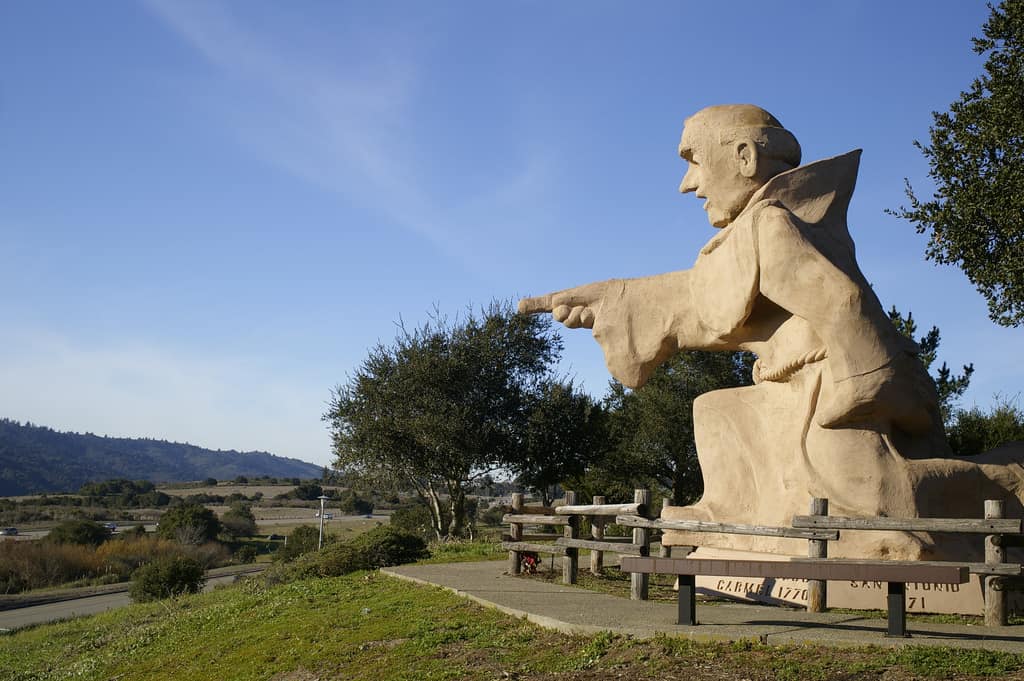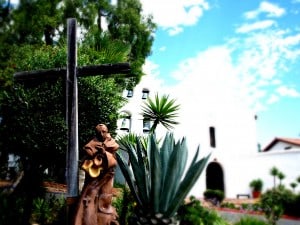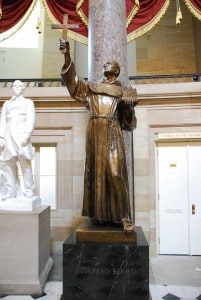As part of my graduate history studies, I researched the Native American communities who had inhabited the area around Newberry National Volcanic Monument. I began my research at the New York branch of the National Museum of the American Indian. Located on the southern tip of Manhattan, the museum occupies the old Alexander Hamilton U.S. Custom House. The museum exhibits are installed in rooms off a rotunda bearing beautiful paintings on the ceiling.
I had a startling realization there – all of the paintings on the ceilings were of European conquerors. Christopher Columbus, Francisco Pizarro, and Hernando de Soto all looked down from the rotunda as champions of commerce. The paintings are reminiscent of The Apotheosis of Washington, where George Washington ascends into the heavens. The standard narrative of these men is that they were great explorers, with burning passion to bring geographical knowledge back to Europe. These are men we might consider heroes. But saints? Probably not.
Columbus’ story in the United States frequently gets the most emphasis. In the early 1900s, Catholics struggled to find acceptance in this country. They sought a hero who the Protestant populace would respect. Italian miners in Colorado pushed Columbus. The aptly-named Knights of Columbus took up the call, eventually winning a federal holiday for the sailor and cementing his three ships in American lore.
In high school, I learned a much different story. I came to know Columbus the destroyer, whose troops raped and pillaged. I came to know the Columbus who lusted for gold and kidnapped indigenous children to put them on display in Europe. As a historian in training, I often find myself looking at our collective understanding of ‘heroes’ in order to determine whether or not they are heroes, or robber barons, entrepreneurs, cowboys, or visionaries. And again: what about saints?
****
Pope Francis recently announced that he intends to canonize Father Junípero Serra during the upcoming papal visit to the United States. Father Serra served as a Franciscan missionary in California from 1769 to 1784. Every California fourth grader (at least according to my brother Jesuits) learns about the history of missions. This history frequently sanitizes stories of Serra like they do that of Columbus around the rest of the United States.
Serra grew up on Majorca, Spain where he joined the Franciscans. After his training, Serra traveled to Mexico to teach at the Colegio de San Fernand. Serra became adamant about serving in the missions. He translated the catechism into native languages and sought to generate converts.
In 1769, Serra moved to the missions in Baja. From there, he launched missionary expeditions to the north. Throughout the rest of his time in California, Serra started twenty-one missions along the western coast. He hoped to convert indigenous peoples not only to Christianity, but to farming culture as well. As Catholic Online describes it, “The converts were taught sound methods of agriculture, cattle raising, and arts and crafts.”
Serra saw his as a civilizing mission – transforming indigenous persons into subjects loyal to Church and king. Adopting Christianity included adopting a proper Christian lifestyle. Serra believed that the indigenous peoples he hoped to convert needed to stay close to the mission. They should take on sedentary lifestyles suitable to farming. Their nearness to the holiness of the mission would prevent them from returning to what many then called savage lifestyles. Serra strictly controlled movements – converts could not socialize with those who had not adopted Christianity. Moreover, they had to attain travel passes to be away from the missions. These reminded several French observers of the time (as they remind me) of those that slaves in the South had to obtain.
This missionary work accompanied military advance up the coastline. Spain sought resources to extract, primarily precious metals. The military hoped for colonies where indigenous peoples would work and send wealth back to Spain. Serra remained wary of the colony’s government, however, and refused to let converts adopt Spanish Enlightenment thinking. Nevertheless, the Spanish government saw Christian conversions as a way to entrench Spanish rule in California.
****
Father Serra is one of four Catholic priests standing in the hundred-member National Statuary Hall Collection of the U.S. Capitol. Another, Damien of Moloka’i, has already been canonized. (The two stone non-saints are both Jesuits: Eusebio Kino and Jacques Marquette.) The statues in the hall represent two prominent persons from every State. Serra is one of California’s two. The statues around the hall stand for the history of each state, as well as the values those states wish to emphasize in their history.
Serra has received praise from Catholics who saw him as the bearer of evangelization in the United States. He is also the patron saint of vocations and has an international vocation group in his honor. Others consider his story much more sinister. Theologian and Native American George Tinker states in his text Missionary Conquest that Serra’s canonization amounts to “the canonization of genocide in California, of Europe’s military victory in the Americas, and of the global conquest of capitalism” 1.
****
Historians have tremendous impact on our understanding of the past, particularly the legacy of prominent figures. How future generations interpret the past can change drastically depending on how historians write about it. Historians can neither know nor convey all of the facts of a situation, nor can we share them without bias. I find this challenge less problematic for figures like Columbus. I am comfortable portraying him as European explorer with a nasty penchant for plunder and spreading disease. He can simultaneously be inquisitive explorer and destructive maniac.
I am not comfortable doing the same for saints. When I imagine a saint, I see a person who perhaps led a mediocre or sinful life at first. But they turned it around and became good, holy people. Sin was a thing of their past. I envision saints as historically uncomplex characters. But this linear progression of bad-to-good lacks historical justification.
Serra’s life does not lend itself to stagnant or linear understanding. Tinker points out that Serra used whippings and withheld food to augment his control. He also fought to prevent interaction between the Spaniards and Indians. Serra believed that the soldiers would take advantage of and enslave indigenous persons. He furthermore demanded that soldiers return stolen land to the indigenous farmers. Simultaneously, however, Serra pushed new converts into hard labor, preparing the land for farming.
Several newspapers have picked up on the strong reaction against Serra’s canonization. Of those interviewed in an article by The Guardian, several see Serra having different levels of culpability. Deborah Miranda, literature professor and an Ohlone Costanoan Esselen Indian, sees Serra as complicit in the evils that happened. He was not always a perpetrator. But he is responsible for not stopping them.
The executive director of the California Missions Resources Center, David McLaughlin, believes Serra to be a holy man constrained by the thinking of the day. In her piece in Indian Country Today, Deborah Miranda states many commentators like McLaughlin have excused Serra for simply following common practice. She says that these same commentators have dismissed comparing Serra to Hitler, calling such comparisons hyperbolic. These same commentators do not, however, excuse Hitler for simply following the thinking of his day. Eugenics was a widely popular theory at the time. Yet nobody lets Hitler off the hook. There is some validity to Miranda’s point.
Yet to reduce Serra to a perpetrator of genocide does a disservice to other Native American tragedies and massacres, as well as the history. Hyperbole is an exceedingly dangerous tool in history. Serra did not set out with a plan for the mass murder of a people. He did not actively seek to annihilate a civilization. Overuse of the word genocide detracts from those who have suffered it. Serra did not murder, but he did participate in the destruction of cultures. His absolute insistence on Spanish-style Catholicism forever wiped out indigenous traditions, languages, and lifestyles.
****
As a Catholic and history student, I seem to feel my brain ruminating about these questions. Can I support Serra’s canonization? Does canonizing an individual canonize the system and injustices he participated in? Perhaps most difficult is that, in the end, I have to see Serra as a human. I cannot watch him as a distant pure figure, untouched by the sin of the world. He lived. He sinned. Does this make him less of a saint? What if it makes him more relatable as a saint?
For me, saints are attractive because they can function beyond my own limits. As my high school English teacher Frank Kovarik told us about Odysseus, even heroes have shortcomings. But saints!? I imagine them rising above whatever stumbling blocks impeded them to arrive at a state of goodness somehow out of reach for the rest of us. St. Ignatius overcame his arrogance to lead a religious order. St. Francis rejected his wealth for a life of radical poverty. But Serra has dirt on his hands. Not only dirt, but blood stains as well. Is this “heroic virtue”?
Perhaps worst of all, Serra’s shortcomings mean something even more difficult for me: that even I can have saintlike qualities. We’ll set the record straight here. I’m not a saint and I don’t have miracles to my name (unless you count not eating the whole jar of M&Ms every time I walk past it). But the opportunity lurks. When I see saints as examples of placid perfection, there’s no pressure for me to emulate them. I can dismiss their holiness as beyond my scope. But a guy like Serra? Well, I may not actively whip anyone, but I participate in many systems of injustice whenever I purchase food and clothing. And I know I am morally culpable for those, even if they are simply part of the times.
I do not know how Serra fits in the canon of colonial history. He is neither a straightforward conquistador nor a straightforward violator of rights. The forthcoming canonization of Serra will likely be greeted with great celebration for those who have been advocating his beatification for many years. For others in the Native American community, it will be another jab in an open wound.
In the end, we can use the canonization as an opportunity to learn more history from Native American communities, to listen to what we learn when the poor write history, and to seek forgiveness. We, like Serra, did not always commit the sins. But we have inherited and sometimes celebrated those sins. It is imperative that we ask forgiveness. As a saint, I can only imagine Serra would want reconciliation – no matter the state of his ultimate legacy.
–//–
Cover image by Mike Fernwood via Flickr.
- Tinker, George. Missionary Conquest, 67. Minneapolis, MN: Fortress Press, 1993. Book. ↩




